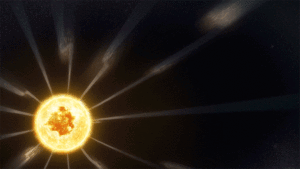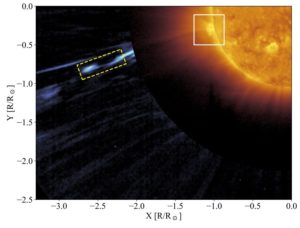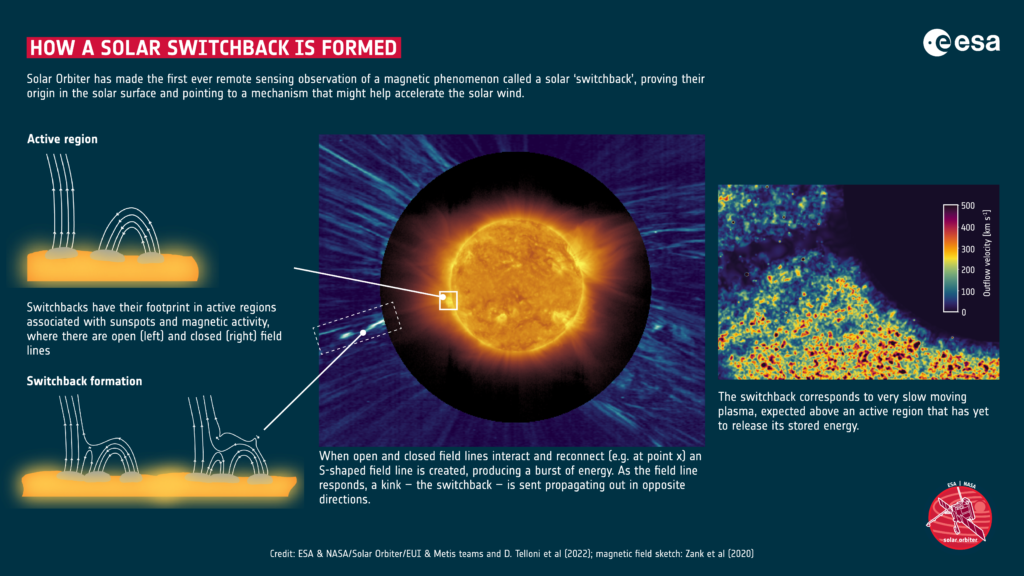Observation of magnetic switchbacks in solar corona
Article in press on “Astrophysical Journal Letters” ; https://arxiv.org/pdf/2206.03090.pdf
The solar wind is a continuous flow of supersonic plasma particles generated at the level of the Solar Corona – the Sun’s atmosphere – that expands radially, reaching the planets of the solar system and creating a large bubble of plasma that extends well beyond Pluto’s orbit, called the heliosphere. Together with this plasma flux, the Sun generates also a large scale magnetic field that pervades the heliosphere, carried within the solar wind. In 2019 NASA has launched the Parker Solar Probe – PSS, a mission designed to explore magnetic, electric and velocity fields in the solar wind, performing the closest approaches to Sun ever made by a spacecraft.
Soon after its launch, PSS has discovered the existence in the Solar Corona of abundant clusters of S-like structures called “switchbacks (see the animation below). These are essentially short-term ‘flips’ in the polarity of the magnetic field frozen in the outflowing solar wind, which may actually play a critical role in the creation and acceleration of the solar wind.

Parker Solar Probe observed switchbacks: traveling disturbances in the solar wind that caused the magnetic field
to bend back on itself. Credits: NASA’s Goddard Space Flight Center/Conceptual Image Lab/Adriana M. Gutierrez
While in the last couple of years, thanks to PPS, switchbacks have been widely observed near the Sun and the international community has worked on their characterizations, no theory has been put forward to date that explain their origin, as is reported in this recent articles on the NASA website:
https://www.nasa.gov/feature/goddard/2021/switchbacks-science-explaining-parker-solar-probe-s-magnetic-puzzle
The main question concerning this very peculiar magnetic structures, essential to explain the dynamics of the solar wind is: do the switchbacks have a solar origin or they form locally in the solar wind, as it expands into the interplanetary space?
This puzzle has finally been solved thanks to the a breakthrough discovery made by a team of scientists working on the ESA Solar Orbiter – SolO mission (launched in the February 2020), based on the first direct observation of a magnetic switchback in the Solar Corona, done with the METIS coronographer on board of SolO. In an article that will soon appear on “The Astrophysical Journal Letters (ApJ)”, Daniele Telloni, from the Italian National Institute for Astrophysics, co-investigator of the METIS, in collaboration with Raffaele Marino, CNRS scientist at the LMFA /Ecole Centrale de Lyon, Co-investigator of the plasma suite SWA on SolO, together with a team of worldwide recognized scientists from many countries, propose indeed a theory that would explain the origin of the magnetic switchbacks.

Composite of the Metis-observed total brightness image of the solar corona (blue) and of the ultraviolet emission image (yellow) provided by the Extreme Ultraviolet Imager from the Solar Orbiter vantage point on March 25, 2022 at 20:39 UT. The switchback (in the rectangular box) propagates through the Solar Corona, above an active region of the Sun (white box).
Telloni and Marino say: “the novelty of our work relies on presenting to the community the first observation of a magnetic switchback in the Solar Corona, together with a rigorous evidence based explanation of the SBs origin. As we explain with solid arguments in the manuscript just accepted in ApJ, we were able to interpret the generation of the switchbacks in space plasmas as the result of the interchange reconnection occurring between closed magnetic structures developing above active regions of the Sun and the open magnetic field lines emerging from neighbor of coronal holes, which suggest a common genesis for the magnetic switchbacks and the slow solar wind streams”.
The authors make the claim that the large scale S-like plasma structure observed in the Corona with the METIS instrument (shown in the figure above), in a region susceptible to contain the inversion of the local mean magnetic field, is indeed compatible with the existence of an underlying magnetic switchback. This is substantiated by a thorough spatio-temporal analysis performed using the METIS data, and by the outcome of (numerical and analytical) models of the coronal plasma and its magnetic field that have been ran in order to interpret the observations. According to Telloni and Marino, phenomenological evidence and quantitative assessments presented in their work provide critical elements leading to conclude that the observed plasma structure is supported by a large magnetic switchback in the Corona, occurring in a site where the probability for interchange reconnection to develop is high.
 Schematics of the interchange reconnection mechanism [from Zank et al. 2020, ApJL, 903,1] proposed to explain the origin of the magnetic switchbacks. a) a coronal loop (massive closed magnetic structure developing over the Sun’s surface) approaches a region with open magnetic field lines; b) the first magnetic field line “reconnect” asshown, producing a S-shaped open magnetic field line; c) the switchback is then pushed both upward and downward (as the arrows indicate in the sketch), while a new reconnection event starts on the subsequent neighbor field line, interacting with the same coronal loop.
Schematics of the interchange reconnection mechanism [from Zank et al. 2020, ApJL, 903,1] proposed to explain the origin of the magnetic switchbacks. a) a coronal loop (massive closed magnetic structure developing over the Sun’s surface) approaches a region with open magnetic field lines; b) the first magnetic field line “reconnect” asshown, producing a S-shaped open magnetic field line; c) the switchback is then pushed both upward and downward (as the arrows indicate in the sketch), while a new reconnection event starts on the subsequent neighbor field line, interacting with the same coronal loop.

